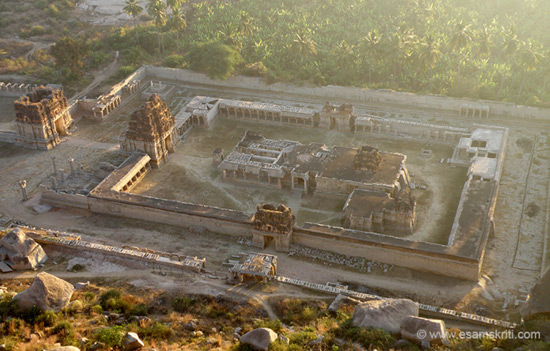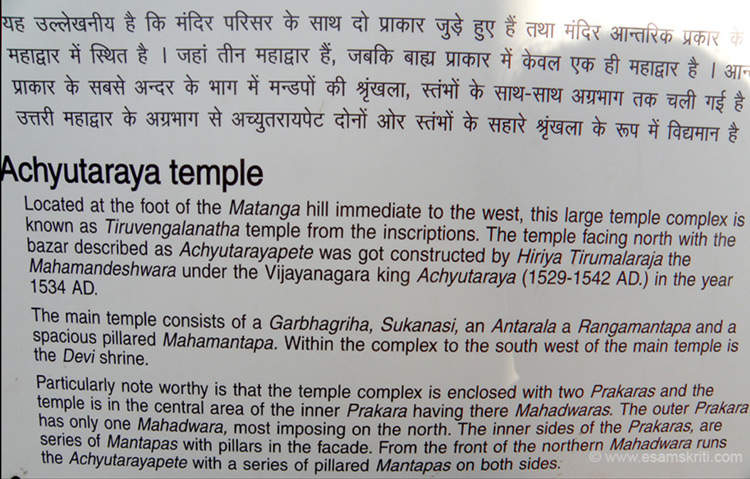- Know about the life and achievements of Achyuta Deva Raya, the Vijayanagar
King who ruled after Krishna Deva Raya.
In history
of India, the contribution of Vijaynagar Empire is unparalleled. Under the
victorious reign of Krishna Deva Raya, it peaked. However, after him the
history of Vijaynagar is ignored and his successors were generalized as weak,
and incompetent. One such worthy successor was Achyuta Deva Raya.
After Krishna Deva Raya, if there was one king who preserved the glory of empire, created fear among his enemies it was Achyutadevaraya. He carried was a good administrator and patron of arts too.
Early
life
Achyuta was born to Narasa Nayaka and Obamambika. He was the younger half brother of Krishna Devaraya. There’s no specific mention about the date and birth year of Achyuta. During his childhood he was given necessary education on polity, dharma shastras and all kinds of physical training. Narasa Nayaka died when Achyuta was a teenager. Achyuta helped in many military adventures of his elder half brother Veera Narasimha and later in the conquests of Krishna Devaraya.
After the
death of crown prince Tirumala Raya in 1524, Krishnadevaraya had to think of a
successor. He chose his younger half brother Achyuta. Due to his failing health
he permitted Achyuta to rule on his behalf from 1526. (Contemporary sources
like Penukonda Kaifiyat and some inscriptions mention the co-rule of Achyuta
from 1526). Achyuta enjoyed complete faith of Krishna Deva due to previous
achievements and capabilities.
Achyuta becomes King and Wars
Krishnadevraya
died in October 1529. At that time, Achyuta Raya was in Telugu country. After
hearing this news he rushed towards Hampi. He first went to Tirupati to take
blessings of family deity where he was coronated. Next he went to Kalahasti where
again he was coronated. Finally he reached Vijaynagar in November 1529 where he
celebrated his coronation with great pomp and grandeur.
Digressing a
bit here is an excerpt from volume 7 of The
History and Culture of the Indian People published by the Bharatiya Vidha
Bhavan Pg. 486 To avoid dissension he entered into an agreement with Krishnadevaraya’s son-in-law Ramaraya whereby the latter was his partner in the administration of the empire.
However, Achyuta’s initial days were tough. After hearing about death of Krishna Deva Raya the Gajapatis of Orissa and Qutb Shah attacked Vijaynagar. Achyuta moved towards the eastern frontier and defeated the Orissa army. (the Urattur inscription of 1531 mentions this defeat of Oriya army by Achyuta). After defeating Gajapatis he turned his attention to Qutb Shah. He defeated Shah and forced him to retire to his country. Urattur inscription calls Achyuta as “Terror in minds of Turushkas “. His commander Velugoti Timma Naidu defeated Shah and killed three of his commanders in the Battle of Rompicerla.
Thus by
swift actions and military prowess, Achyuta thwarted invasions and secured the
eastern frontier of the empire.
 Achyuta Raya Temple, Hampi. View from Matanga hill.
Achyuta Raya Temple, Hampi. View from Matanga hill. Temple board.
Temple board.
After
dealing with external threats he turned his attention to internal rebellions.
Saluva Nayak
revolted against him and was joined by Tumbicci Nayak. Both the rebels captured
Pandyan country and expelled the king, who was a Vijaynagar loyalist. The king
asked Achyuta for help who moved towards the south. Achyuta faced the combined
army of rebels and defeated them.
The defeated
rebels fled to Travancore kingdom or Tiruvadi Rajyam. The ruler of Travancore
also allied with rebels. Achyuta marched and defeated the three rebels. The
battle was fought on the banks of Tamraparni river. The rebels submitted to
Achyuta. After dharmic ceremonies at various temples, Achyuta returned to the capital
in 1532.
While Achyuta was busy in repulsing Gajapatis and Qutb Shah, Adil Shah allied with Berar and Bidar Sultanates, attacked Raichur and captured it in 1530. After he was freed from these invasions and rebellions, Achyuta launched an offensive against Adil Shah. In 1534 he marched with a huge army towards Adil Shah’s kingdom. His invasion created havoc in Bijapur and was brutal. Every fort enroute was dismantled.
After hearing this, Mallu Adil Shah gathered his army. Both armies fought a battle around Raichur. This battle resulted in the wholesale massacre of Adil Shah’s forces. Adil Shah fled from battlefield. Achyuta got huge amount of booty. Later Mallu Adil Shah surrendered, accepted his defeat and proposed a peace treaty. Achyuta recaptured Raichur and returned to his capital.
While
Achyuta was busy fighting Ramaraya (son-in-law of Krishna Deva Raya) removed
old servants from key positions and appointed his own men. He also took into
service 3,000 Muslim soldiers whom Adil Shah discharged from his service. (Pg.
486 Bhavan)
After
defeating Adil Shah, Achyuta turned his attention towards chieftain of Gutti
named Timma Naidu and defeated him in 1535. A Tanjore and Enniyaram (Arcot) inscription
of 1539 refers to Achyutas conquest of Ceylon (modern day Sri Lanka ).
The conquest of Ceylon was his last
military campaign. He remained undefeated in his campaigns and his victorious
march once again established the superiority of the empire.
He ruled from 1530-1542.
Considering the magnitude of Achyuta Raya’s achievements he can be favorably compared with other illustrious rulers of the Vijayanagar.
It must be
added that due to the infighting between Achyuta and Ramaraya, Adil Shah of
Bijapur invaded Vijayanagar and induced the two to enter into an agreement, the
terms of which were observed by both parties till Achyuta passed away in 1542.
Note that Ramaraya ruled from 1552-1573.
Patron
of Art and Culture
Achyuta Raya inherited his predecessor’s passion for literary works, and hence the literary activities continued uninterruptedly during his reign. Inspite of not being a scholar Achyuta Raya desired to gather around him, poets, philosophers, and religious teachers, in whose company he spent most of his time, listening to their learned discourses and discussions.
Prominent
among them were Rajanatha Dindima (author Achyutarayabhyudayam)
and Bhagavat Champu. Ramayamatya (author of treatise on music), Vyasatirtha (prominent
author on logic) and Dvaita, all of whom flourished during his reign. Along
with Sanskrit works, Telugu and Kannada literature also flourished under the
patronage of Achyuta Raya.
The reign of
Achyuta Raya was also a golden age for Dharmic esp. Vaishnava literature.
 View of Matanga hill and Achyuta Raya temple gopuram in Hampi.
View of Matanga hill and Achyuta Raya temple gopuram in Hampi.
He continued
the policy of temple building and renovation. Inscriptions at Vitthala Temple
in Hampi describe the temple renovation zeal of Achyuta Raya. He built many
temples and renovated many like Kanchi, Tirupati, Kalahasti, Ahobalam etc. His
vassals like Saluva Timma and Nadadla Gopa built many temples too.
He also worked for the betterment of common people. He eradicated marriage taxes and marriage pandal taxes and would redress people’s grievances swiftly. He allowed people the right of direct appeal to the government.
Achyuta Raya
consciously lived up to the tradition of Hindu Kingship. It is a heartening
phenomenon to note that he administered the Empire directly, commanded the
troops personally, toured incessantly all over his extensive territories, built
and endowed magnificent temples and gave charities liberally.
Pre-eminent
as a warrior, Achyuta Raya was equally great as a statesman, an administrator,
and a patron of arts. He was in no way less famous for his religious zeal and
catholicity. He respected all samprayadas
of Sanatana Dharma even though his personal leanings were towards Vaisnavism.
Till his
death in 1542, Achyuta Raya upheld the magnificence of the Empire, and the
ideals for which it stood. He not only gave peace, prosperity and cultural
supremacy to his people, but also stood as a bulwark against Muslim invasions,
thus following the noble ideals of the founders of the Empire.
To read all
articles by author
To know about
all the monuments at Hampi and to see album links
To read about
Vijayanagar Kings and Empire
To read all
articles on Indian History